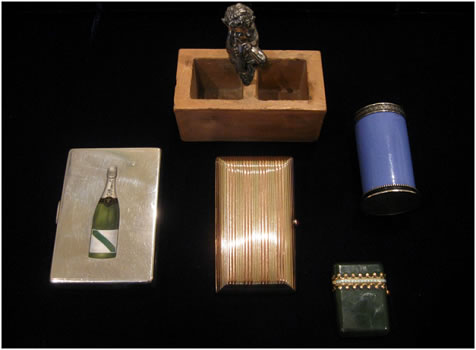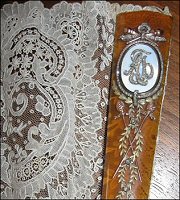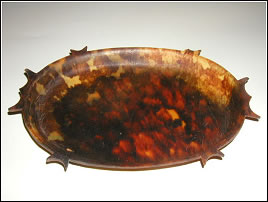
Imperial Swan Egg by Fabergé
(Courtesy Magazine Antiques)
Maurice Yves Sandoz (1892-1958) over a period of 22 years acquired a collection of automatons created by late 18th and early 19th century goldsmiths and watchmakers, and Fabergé in the beginning of the 20th century. Videos in 2D and 3D depicting the movements of the automatons will accompany the exhibition as well as contemporary interpretations by the watchmaker/restorer Parmigiani Fleurier. The firm did the conservation and restoration work of the Yusupov Egg in 2007 and the Peacock Egg two years later. The multi-volume catalogue raisonné, Montres & Automates: La Collection Maurice Sandoz, will be presented for the first time along with an exhibition catalog by A La Vieille Russie. (Source: Magazine Antiques, September/October 2011, cover illustration, 33, 106-113.)


Konstantin Krijitski – Danish Palaces Egg
(Courtesy of the Authors and New Orleans Museum of Art)



Kejserens Villa on the Egg – Villa in 2011 Malaya Morskaya Street, 14
(Courtesy New Orleans Museum of Art and the Authors)
The 100th anniversary of Krijitski’s tragic death was celebrated in Russia this year. He committed suicide after being persecuted in the press. He was accused by the young artist Jacob Brovar of plagiarism in the picture Spring Is Coming. Possibly there were reasons for the accusations, but maybe both artists used the same postcard for the composition. Krijitski was buried at Smolensky Cemetery in St. Petersburg. According to Orthodox Church traditions, a self-murderer has no rights for a real funeral service, yet his grave is located very close to Smolensky the Mother of God Church. Grand Duchess Maria Pavlovna, the president of the Imperial Academy of Arts, took part in the funeral ceremony and in the newspaper, Novoye Vremya (New Time, 1911) were placed these words: “Unheard-of misfortune has happened: one of the most gifted artists, patriot of Russia K. Krijitski, killed himself. As sometimes a deer in tundra dies stung all over with cloud of midges, a poet of our nature became a victim of dirty newspaper harassment …” In 1912, the Society of Help to Poor Artists commemorating the memory of Krijitski was established under the patronage of Grand Duchess Olga Alexandrovna. She became the President of the Society and the meetings of the members took place in her palace in St. Petersburg, Chaikovsky Str., 46/48, formerly Sergievskaya Str.

Spring is Coming (Brovar left) in Novoye Vremya – Krijitski Painting and Artist (right)

Grave of Konstantin Krijitski
(Courtesy of Galina Korneva)
Fabergé objects produced in Moscow are usually not traceable in the archives of the Ministry of the Imperial Court. However, it appears likely the candelabra were produced for the wedding and coronation celebrations of Nicholas II and his wife Alexandra Feodorovna in November 1894 and May 1896, respectively. Very few candelabra appear in Fabergé invoices, yet there is one instance in which candelabra are mentioned in the extensive correspondence related to the wedding of Tsar Nicholas II. These documents, held in a file titled “On Expenditures Incurred on the Occasion of the Marriage of His Imperial Majesty Nicholas Alexandrovich”, include correspondence regarding commissions to Fabergé for silver decorative and serving pieces; an invoice from Fabergé lists the following items made for the coronation:
Additional archival research is needed to prove my supposition. I examined the profusely illustrated coronation albums and the silver inventory of the Imperial palaces (Baron A. Foelkersam, Inventaire de l’Argenterie conservée dans les garde-meubles des Palais Impériaux, St. Petersburg, 1907). Unfortunately, the coronation albums are illustrated only with group portraits and photos of the gifts given to the emperor rather than items ordered for his own use. Foelkersam’s inventory, although published in 1907, seems to contain none of the items ordered for the coronation. Finally, the French control marks confirm these pieces were identified by the Soviet authorities for sale after 1917, probably because they were of the best quality and highly saleable.
November 4, 2011 Olivier Coutau Begarie Paris
Russian Art, Fabergé & Historical Souvenirs
Auction includes a dozen Fabergé objects.
November 15-16, 2011 Jackson’s International Auctioneers, Cedar Falls, Iowa.
World Treasures – Chinese, Russian, Old Masters and European & American Fine Art
Auction features the Dr. John Sinsky (Milwaukee, Wisconsin) lifetime collection of Russian decorative arts, including over 40 pieces of Russian silver and enamel including numerous works by Fabergé as well as Rückert, Ovchinnikov, Khlebnikov, Kurlykov, Lubavin, the Artels, etc., and 40 Russian icons.
November 28, 2011 Christie’s London
Russian Works of Art
Highlights include: Imperial cigarette case presented by Emperor Nicholas II to Commandant-General Carl Casten Abraham Warberg in Stockholm in 1909 by August Hollming and a rhodonite miniature desk clock by Henrik Wigström.


Imperial Cigarette Case – Rhodonite Miniature Desk Clock
(Courtesy Christie’s London)
The Russian Sale
Two illustrated jewelry albums belonging to Grand Duchess Xenia (1895-1960), sister of Nicholas II, depict an itemized record of jewelry received by her between 1880-1912. The auction catalog description does not identify objects made by Fabergé.
November 30, 2011 Sotheby’s London
Russian Works of Art, Fabergé and Icons
An assortment of smoking accessories popular during the Romanov era will be under the hammer. Smoking in Imperial Russia “began in the 17th century and was banned by Tsar Alexis, who decreed that first-time offenders should be whipped, exiled to Siberia, or have their noses slit; a second offence was punishable by execution.” (Romanov Heirlooms: The Lost Inheritance of Grand Duchess Maria Pavlovna, Sotheby’s London, November 30, 2009, 58)

Smoking Accessories
(Photograph C. McCanless)
Left to right: Two cigarette cases, one for a gentleman with the logo of the G.H. Mumm & Cie., wine champagne producer and merchants (still in existence today with the same logo), and a lady’s cigarette case. Of particular interest is in the blue ceramic spill vase used to store splints from a tree to light a cigar or a cigarette from a fire. Matches were expensive and quite short as shown in the small matches case (lower right), so the use of shavings from a tree was a less expensive way to light a cigarette. The base of the nephrite match safe has a tiny ribbed striking surface.
Nigel K. Ross in his article “The Match Safes of Karl Fabergé” (Silver Magazine, January/February 2000, 22-25), states match safes or match boxes, as they were called in the London Sales Ledgers, did not represent a large part of the Fabergé inventory. From July 1913 to July 1914, 581 objects sold in London of which 107 were cigarette cases and only nine were match safes. Our thanks to Darin Bloomquist of Sotheby’s London for sharing Fabergé objects with the newsletter editors.
The Auction House of the Russian Federation (AHRF) is the first auction marketplace established for sales of private property over the whole territory of Russia. It is the joint project of Sberbank of Russia and the Property Fund of St. Petersburg OJSC. Established according to the direction of the Government of the Russian Federation in August 2009, the company is a public corporation, and held its first auctions including Fabergé objects in December 2010 and June 2011. The next auction of Russian antiques is scheduled for November 26, 2011.


Fabergé Brooches
(Courtesy AHRF)
A fairly complete run of Sotheby’s and Christie’s magazines from 1980 to 2011 and scattered issues from the 1960-70’s are available from Jeffrey Eger. The monthly issues represent coverage of auctions worldwide. More recent issues contain background articles about single owner sales, or significant pieces of art written by in-house experts. Individual issues may be purchased.
(Updates are posted in Exhibitions on the Fabergé Research Site)
March 17, 2011 – January 29, 2012 Liechtensteinisches Landesmuseum, Vaduz, Liechtenstein
Das Osterei – Liebespfand und Kunstobjekt
The exhibition including the Apple Blossom Egg by Fabergé has been extended.
October 21-27, 2011 Park Avenue Armory, New York City
International Fine Art & Antique Dealers Show
The Fabergé dealers A La Vieille Russie and Wartski will be exhibiting.
October 22, 2011 – January 15, 2012 Frick Art & Historical Center, Pittsburgh, PA
Fabergé: The Hodges Family Collection
The Hodges Collection is still growing and judging from the enthusiasm of its collector, it will never be a static collection. It was the privilege of the newsletter co-editors to assist Dr. Hodges in his research journey for sixteen of his treasured objects (”Discovering Historical Collections” in Keefe, John W. et al., Fabergé: The Hodges Family Collection, 2009, 11-23). The research tools used encompassed historic and contemporary resources.
Historic Sources:
- Design sketches from the Albert Holmström workshop for the years 1909-15, and from the Henrik Wigström workshop for 1903-18. The latter were published by Dr. Ulla Tillander-Godenhielm in 2000 and 2008.
- Sales Ledgers (1906-17) for London Fabergé branch
- Archives of the Cabinet of His Imperial Majesty, Fond 468, open for research in St. Petersburg, Russia
- Direct descent family stories
Contemporary Sources:
- Scholarly publications
- Auction catalogs by subscription, in libraries, or on the web for Christie’s and Sotheby’s
- Internet resources with verification in primary source material
Our thanks also to Dr. Hodges for his generosity in allowing us to publish the current research for the Bismarck Box, an Imperial Presentation gift in 1889 from Tsar Nicholas II to the German Chancelllor Otto von Bismarck (1815-1898) in the (Fabergé Research Newsletter, Summer 2011 Special Edition).
October 26 – November 26, 2011 A La Vieille Russie, New York
Mechanical Wonders: The Sandoz Collection (see Feature Story)
May 15-25, 2012 Wartski, London
A Diamond Jubilee Tribute: Fabergé from a Private Collection

Anne Odom (1935-2011)
The suggestion has been made that Fabergé carvings fall into two types – naturalistic studies and animals as cartoon. The late A. Kenneth Snowman in his publications pointed out if the animal looks as if it is about to come alive with its typical movements, such as a cat pouncing on a mouse, it is genuine Fabergé.
Dr. Géza von Habsburg in the publication, Fabergé Revealed (2011, 347-356), presents a variety of animals with their possible origins. In his curatorial work with the Pratt Collection, Virginia Museum of Fine Arts, he attributed 16 out of 37 animals to Fabergé based on original fitted cases, their hallmarks, or their quality, while eleven are by or probably from the firm of Cartier which between 1904 and 1911 supplied the same Russian clientele as Fabergé. An easy solution for the identification of hardstone animal carvings by Fabergé has so far escaped the experts, and beauty continues to be in the eyes of the beholder.
Tour of the Royal Fabergé – An Exhibition venue narrated by Caroline de Guitaut is on the web at YouTube. Duration 3.20 minutes. Catalog of the exhibition by the same name available in the Royal Collection shop.
Spala: An Imperial Palace by Svetlana Chestnykh, Karen Kettering and Michał Słoniewski is a brand-new publication with text in Polish, Russian, and English based on photographs from archives in Moscow, St. Petersburg, and the New York Public Library. The authors have reconstructed through a profusion of original photographs and explanatory text the history of the palace and the daily lives of Tsars Alexander III and Nicholas II and their families at the Imperial hunting lodge at Spala where today only the tall brick water tower remains. In the section Gifts from the Cabinet of His Imperial Majesty design sketches and a few Fabergé objects relating to the story are illustrated.

Royal Fabergé

Spala: An Imperial Residence

Star Frame Clock
(Courtesy Royal Collection)

Star Frame
(Courtesy Pratt Collection)
A few lines about my godfather’s background: Sidney Wilhelm Heliodor Landberg was born in 1877 in Stockholm, Sweden, and died in Helsinki, Finland, in 1958. He was only 13 when he started his marine career in Revel, Estonia, as a seaman and steward on brigs and barks. His uncle, general manager of the Russische-Baltische Bergungs-Verein in Revel (cited as The Revel Rescue Society by Korneva-Cheboksarova) in 1896 offered him work in his society. Young Sidney had already experienced life on the oceans by crossing the Atlantic Ocean a dozen of times and rounding the Cape of Good Hope as well. He passed his first mate and captain examination in Baltischport (Estonia) and worked for his uncle’s company until World War I, covering the Baltic Sea and the Gulf of Finland.
In September 1907 when the Imperial Yacht Standart during its summer cruise in the Finnish archipelago ran aground in the Rilax Bay Sidney Landberg happened to be stationed in Hanko, not far from the scene of the accident. He was dispatched by his company, the Russische-Baltische Bergungs-Verein, to rescue the Imperial Yacht. Finnish salvage ships had also been contacted and worked together with the Revel company ships to rescue the Standart. Of special interest is the fact that the honor and marks of distinction for rescuing the Imperial Yacht were conferred only on the representatives of Russische-Baltische Bergungs-Verein in Revel.
In a retrospective log-book or curriculum, written probably about 1920, Landberg says he sailed for the Standart in the morning of September 4th (o.s.), and he continues: “Worked for about three weeks together with s/s Meteor and Karin. Then convoyed s/s Standart to Kronstadt. The Imperial family [was] on board all the time during the salvage work. Received the order of Saint Stanislas third class and a golden watch. Salvage pay 125.000 roubles.”
During his almost 50 years of service as a captain of salvage ships Sidney Landberg was the recipient of several marks of distinction and gifts, both Russian and Finnish. One of those is the small golden jetton.




Captain Sidney Landberg (1877 – 1958), Jetton Front, Back and Open
(Courtesy the Author)
More than 50 years after my godfather’s death there are only a couple of individuals who can remember him. A historical account of the Finnish Salvage Company Neptun 1898-1948, where he served from 1921 until he retired on a pension after World War II, gives some information about him and his ship s/s Assistans. I remember him as a most kind and generous person, always helpful to those in need. So it happened, for instance, when his sister in Stockholm in the early 1950’s was in financial difficulty, he authorized her to sell all his awards and watches (which had been transferred to Sweden probably because of the delicate relations between Finland and USSR during and after World War II).
The small golden jetton with forget-me-nots in it, a few lines in a captain’s retrospective log-book and some documents referring to his awards is what remains – but they remind us of Sidney Landberg’s work as one of those who participated in the efforts to rescue the Imperial Yacht Standart when she went aground in the Finnish archipelago in 1907.
Sources Consulted: Family Archives; Sidney Landberg’s Handwritten Retrospective “Log-book”; Historical Account of The Finnish Salvage Company Neptun 1898-1948 by Victor Hoving (1949)

Montures Henrik Wigström
(Courtesy McFerrin Collection)

Monogrammed Guard with Brussels
Lace, Mikhail Perkhin, ca. 1895
(Collection Mrs. Alexander)


